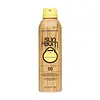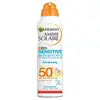What's inside
What's inside
 Key Ingredients
Key Ingredients

 Benefits
Benefits

 Concerns
Concerns

 Ingredients Side-by-side
Ingredients Side-by-side

Butane
Water
Skin ConditioningDicaprylyl Ether
EmollientHomosalate
Skin ConditioningDrometrizole Trisiloxane
UV AbsorberEthylhexyl Salicylate
UV AbsorberDimethicone
EmollientStyrene/Acrylates Copolymer
Octocrylene
UV AbsorberButyl Methoxydibenzoylmethane
UV AbsorberPEG-30 Dipolyhydroxystearate
EmulsifyingNylon-12
Dicaprylyl Carbonate
EmollientMethyl Methacrylate Crosspolymer
Cyclohexasiloxane
EmollientPolymethylsilsesquioxane
P-Anisic Acid
MaskingTocopherol
AntioxidantSodium Chloride
MaskingDodecene
MaskingPhenoxyethanol
PreservativeThermus Thermophillus Ferment
Skin ConditioningPEG-8 Laurate
EmulsifyingEthylhexyl Triazone
UV AbsorberPoly C10-30 Alkyl Acrylate
Emulsion StabilisingPoloxamer 407
EmulsifyingIsododecane
EmollientIsostearyl Alcohol
EmollientPropylene Carbonate
SolventCaprylyl Glycol
EmollientDisteardimonium Hectorite
StabilisingDisodium EDTA
Potassium Sorbate
PreservativeLauryl PEG/PPG-18/18 Methicone
Skin ConditioningGlycerin
HumectantButane, Water, Dicaprylyl Ether, Homosalate, Drometrizole Trisiloxane, Ethylhexyl Salicylate, Dimethicone, Styrene/Acrylates Copolymer, Octocrylene, Butyl Methoxydibenzoylmethane, PEG-30 Dipolyhydroxystearate, Nylon-12, Dicaprylyl Carbonate, Methyl Methacrylate Crosspolymer, Cyclohexasiloxane, Polymethylsilsesquioxane, P-Anisic Acid, Tocopherol, Sodium Chloride, Dodecene, Phenoxyethanol, Thermus Thermophillus Ferment, PEG-8 Laurate, Ethylhexyl Triazone, Poly C10-30 Alkyl Acrylate, Poloxamer 407, Isododecane, Isostearyl Alcohol, Propylene Carbonate, Caprylyl Glycol, Disteardimonium Hectorite, Disodium EDTA, Potassium Sorbate, Lauryl PEG/PPG-18/18 Methicone, Glycerin
 Reviews
Reviews

Ingredients Explained
These ingredients are found in both products.
Ingredients higher up in an ingredient list are typically present in a larger amount.
Also known as Avobenzone, this ingredient is a chemical sunscreen filter that provides protection in the UV-A range.
Avobenzone is globally approved and is the most commonly used UV-A filter in the world.
Studies have found that avobenzone becomes ineffective when exposed to UV light (it is not photostable; meaning that it breaks down in sunlight). Because of this, formulations that include avobenzone will usually contain stabilizers such as octocrylene.
However, some modern formulations (looking at you, EU!) are able to stabilize avobenzone by coating the molecules.
Avobenzone does not protect against the UV-B range, so it's important to check that the sunscreen you're using contains other UV filters that do!
The highest concentration of avobenzone permitted is 3% in the US, and 5% in the EU.
Learn more about Butyl MethoxydibenzoylmethaneDicaprylyl Carbonate comes from carbonic acid and caprylyl alcohol, a fatty alcohol. It is an emollient and gives skin a velvet feel. The sources of Dicaprylyl Carbonate may be synthetic or from animals.
As an emollient, Dicaprylyl Carbonate creates a film on the skin. This film traps moisture in, keeping your skin soft and hydrated.
Ethylhexyl Salicylate is an organic compound used to block UV rays. It primarily absorbs UVB rays but offers a small amount of UVA protection as well.
Commonly found in sunscreens, Ethylhexyl Salicylate is created from salicylic acid and 2-ethylhexanol. You might know salicylic acid as the effective acne fighter ingredient and BHA.
The ethylhexanol in this ingredient is a fatty alcohol and helps hydrate your skin, similar to oils. It is an emollient, which means it traps moisture into the skin.
According to manufacturers, Ethylhexyl Salicylate absorbs UV wavelength of 295-315 nm, with a peak absorption at 307-310 nm. UVA rays are linked to long term skin damage, such as hyperpigmentation. UVB rays emit more energy and are capable of damaging our DNA. UVB rays cause sunburn.
Learn more about Ethylhexyl SalicylateHomosalate is a chemical sunscreen filter that provides protection in the UV-B range (280nm - 320 nm), with a peak protection at 306 nm. It is internationally approved for use in sunscreens.
Homosalate is not photo-stable, meaning it's strength as a UV filter degrades over time with exposure to the sun. Because of this, it's often used in combination with other chemical sunscreen filters as avobenzone (which protects from the UV-A range). Homosalate also helps act as a solvent for harder-to-dissolve UV filters.
(Part of the reason that sunscreens need to be frequently re-applied is due to the photo instability of many chemical sunscreen filters)
Currently, homosalate is approved in concentrations up to 10% in the EU and 15% in the US. The FDA is currently doing further research on the effects of homosalate, and it is possible that these approved concentrations will change in the future.
Learn more about HomosalateOctocrylene protects skin from sun damage. It absorbs UV-B with peak absorption of 304 nm. It is a common sunscreen ingredient and often paired with avobenzone, a UVA filter. This is because octocrylene stabilizes other sunscreen ingredients by protecting them from degradation when exposed to sunlight. Octocrylene is a photostable ingredient and loses about 10% of SPF in 95 minutes.
Octocrylene also acts as an emollient, meaning it helps skin retain moisture and softens skin. It is oil-soluble and hydrophobic, enhancing water-resistant properties in a product.
Those who are using ketoprofen, a topical anti-inflammatory drug, may experience an allergic reaction when using octocrylene. It is best to speak with a healthcare professional about using sunscreens with octocrylene.
The EU allows a maximum of these concentrations:
Learn more about OctocryleneTocopherol (also known as Vitamin E) is a common antioxidant used to help protect the skin from free-radicals and strengthen the skin barrier. It's also fat soluble - this means our skin is great at absorbing it.
Vitamin E also helps keep your natural skin lipids healthy. Your lipid skin barrier naturally consists of lipids, ceramides, and fatty acids. Vitamin E offers extra protection for your skin’s lipid barrier, keeping your skin healthy and nourished.
Another benefit is a bit of UV protection. Vitamin E helps reduce the damage caused by UVB rays. (It should not replace your sunscreen). Combining it with Vitamin C can decrease sunburned cells and hyperpigmentation after UV exposure.
You might have noticed Vitamin E + C often paired together. This is because it is great at stabilizing Vitamin C. Using the two together helps increase the effectiveness of both ingredients.
There are often claims that Vitamin E can reduce/prevent scarring, but these claims haven't been confirmed by scientific research.
Learn more about Tocopherol